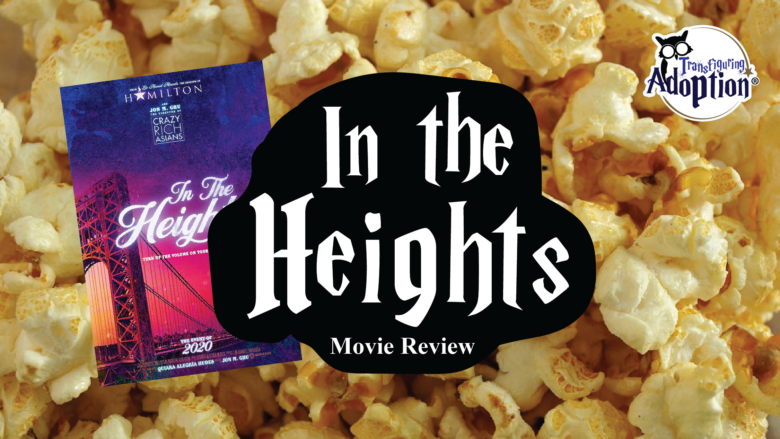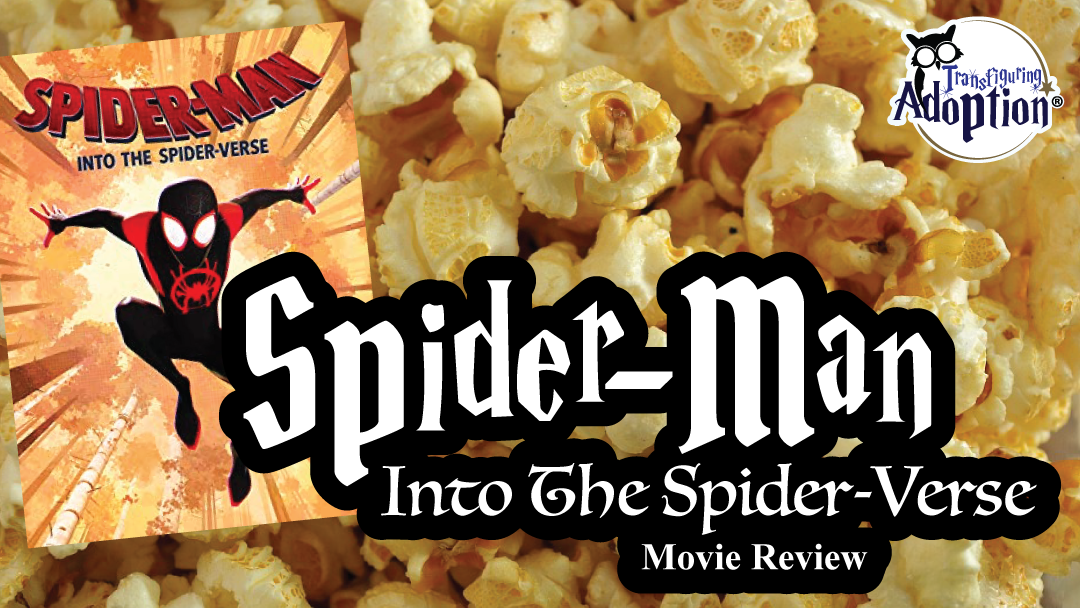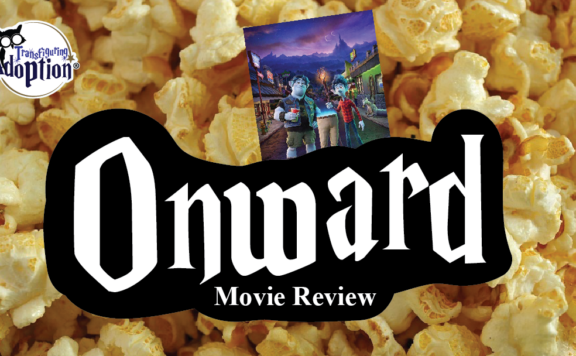Grade:
Transfiguring Adoption awarded this movie 4 Hoots out of 5 based on how useful it will be for a foster/adoptive family. [Learn more about our Hoot grading system here]
Movie Info:
- Rating: PG-13 (Suggestive References, Some Language)
- Genre: Musical
- Runtime: 143 minutes
- Studio: Scott Sanders Productions, Warner Bros., Likely Story, 5000 Broadway Productions
From the Cover of In the Heights (2021) by Warner Bros.:
“The creator of “Hamilton” and the director of “Crazy Rich Asians” invite you to the event of the summer, where the streets are made of music and little dreams become big… “In the Heights.” Lights up on Washington Heights… The scent of a cafecito caliente hangs in the air just outside of the 181st Street subway stop, where a kaleidoscope of dreams rallies this vibrant and tight-knit community. At the intersection of it all is the likable, magnetic bodega owner Usnavi (Anthony Ramos), who saves every penny from his daily grind as he hopes, imagines and sings about a better life. “In the Heights” fuses Lin-Manuel Miranda’s kinetic music and lyrics with director Jon M. Chu’s lively and authentic eye for storytelling to capture a world very much of its place, but universal in its experience.”
Transfiguring Adoption’s Overview:
While In the Heights (2021) isn’t directly related to foster care or adoption, there are many themes around family, community, and cultural connections that are very important for teenagers to consider as they grow and chase their own dreams.
The target audience appears to be children that are ages 13 and up. While I know family’s respond to official ratings differently, I want to urge families to follow with this rating for a few reasons. For one thing, this movie is quite long. Younger children (and even some young teens) will not be able to sit through this one. The second reason is there are several lyrics with sexual innuendo you may not want younger children repeating. However, for families with teens (especially of latinx heritage) this is a fantastic movie experience! How might this movie be relatable to foster and/or adoptive families?
** Spoilers Could Be Ahead **
How Is This Relevant To Adoption & Foster Care?
The film centers around the narrator, Usnavi de la Vega, who came to the United States from the Dominican Republic as a child. He runs a bodega, a corner grocery store, in the Washington Heights area of New York where the neighborhood has largely been populated by various persons of Latinx cultures. Usnavi reveals that he lost his parents at a young age and was largely raised by Abuela Claudia, who never had children of her own and “adopted” the neighborhood children as well as their dreams. Throughout the film, it is emphasized that rent is being raised in the neighborhood and making it harder for long-time Latinx businesses to stay in the Heights. Bills and rent are constant worries for those that live in the area, as well as those like Vanessa that desperately want to get out. Though Washington Heights has its struggle though it has a very tight-knit community and unique support system that Nina, current Stanford student considering dropping out, discovers as she struggles with her identity as a person of color in a very white school. There are other stories of struggle and identity as well as Sonny, Usnavi’s younger cousin, struggles with the limitations of his dreams due to being a “dreamer” (meaning, a child that accompanied undocummented parents into the United States) and Benny struggles with his own desires to love Nina but not wanting to hold her back from “getting out.”
As children with trauma grow into teens with trauma identity becomes a much more complex issue than before, especially for children who are no longer connected to their cultural roots and communities. Like Usnavi, they may look to the past with fond memories and long for the comforts of a time with family and familiarity. Some may also identify with Nina, who is pushed to “get out” and make a better life so intensely their failure feels both equated to those like them or they feel disconnected from communities that offer stability and connection. Others may feel like Vanessa and Sonny and want nothing more than to run for their dreams without abandon but are limited by legalities and a lack of generational wealth to get started. Across the board though, your teen will struggle when they reach adulthood. I’m not saying that they can’t work hard, but if anything many of your children will have to work harder than their peers to overcome a series systemic barriers as well as personal traumas. Though we all hope to be able to work hard and make a living, the reality is much more complicated. If, like Vanessa, if your child doesn’t have a credit history or cosigner their living options will be limited. If they do not have documentation or someone fighting for them to have legal documentation of any sort, they will be like Sonny and severely limited in occupational and educational opportunities. Think of Usnavi and his lack of resources outside of that lottery ticket. And think of Nina being searched for her roommate’s necklace though there was no proof of wrong-doing or that the necklace was even taken. The reality is, though we wish the world was not this way, your child will have a lot of challenges and it is best to be open and frank in conversation about these things while they have a bigger, stronger, wiser adult that cares for them and will talk through these hard topics than to set them loose at 18 to be fatally blindsided.
Discussion Points:
- Cultural Community and Connectivity
When Usnavi and the other characters are going through it, though they appear to lack in familial supports they have significantly high natural supports in the barrio. Whether it’s the emotional support of the ladies at the salon, the connectedness through shared culture and experiences with neighbors, or Abuela’s adoption of the neighborhood kids each character has a unique support that children in foster or adoptive families lack. When a child is uprooted from their family of origin, even when it is for the child’s safety, it’s easy to forget the other losses that child loses. It’s also easy to forget why a child may claw tooth and nail to return to those roots after exiting care to a well meaning foster family. Usnavi’s desire to return to the Dominican Republic due to his “island memories” and Nina’s feelings of loneliness and disconnection are wonderful examples of how children with trauma will feel when disconnected from the comfortable and familiar parts of the past. For children of color especially, being away from cultural connections and kinship supports add to the complex trauma they experience. Caregivers need to be sensitive to this desire for connection, especially when caring for children of color and it is crucial for lifelong success and mental health for your child to have access to cultural connections and community. That way they have more supports while they wrestle with their dreams and ambitions like Usnavi and Nina. Though their surroundings and dreams may change and grow, at the end of the day these connections and supports are necessary to help guide them through challenges unique to their identity and cultures and having more caring adults to add to your child’s support-circle is always a win. This especially true for caregivers that are not a part of the same cultures and communities and may not be as equipped for some of these struggles alone.
- Systemic Barriers to Success/Asserting Dignity in Small Ways
When discussing race and ethnicity, it’s easy for defenses to come up. However, despite what a white caregiver may believe it is imperative that they become comfortable with discussing race and ethnicity when they care for a child of another race and ethnic background. While many are well meaning by saying they are “color-blind”, this viewpoint can be damaging for your child. Children of color need to be aware of the unique barriers that are before them and need to have the space to openly express their feelings as they experience the consequences of systemic racism. I highly recommend reading up on Critical Race Theory if you are not familiar with the concept. Though we all wish that race and ethnicity were not barriers to success in our current society of 2021, the fact is that it absolutely is. Think of Nina attending a benefit banquet and being mistaken for a server in spite of her nice dress wear. Think of her also being one of the only persons of color in her school and as a result being a representative of her race at every action. Think of Sonny being unable to access educational supports because he was brought to the United States in diapers and that the United States is the only home he has ever known. Consider how all the characters may be perceived or labeled because of being from The Heights. And lastly, consider how Nina was searched with no proof when a white roommate’s necklace went missing and never received even an apology for such an over reaction. Every day of existence, your child of color will experience struggles interpersonally and systematically that a white child will not and have added pressures strictly because of their race. This is something that a child needs to be prepared for and have the space to safely discuss with you or other natural supports. Looking inward at internal biases is tough work and is not for the faint of heart, but again this is crucial for you as a caregiver to educate yourself on and examine your relationship with race and CRT as soon as possible so that your child can be safe and be prepared for the challenges they currently face as well as the ones they will face later.
- Difficulty in Transitions
There is a big reason the term “adulting” has taken off within the circles of Millennials (which, by the way, are in 2021 in their 30s) and Gen Z. Transitioning to adulthood is hard work in of itself. If you consider the challenges you had growing up I need you to double that, sprinkle in systemic barriers towards persons of color, add a terrible economy, and it’s even harder. And on top of that, you may be caring for a child that has complex trauma and lacks in natural and familial supports their peers do have. This creates a maelstrom of potential failure in graduating into adulthood! Consider Vanessa having all the money to move to an apartment in another neighborhood but being denied housing due to a lack of credit or a cosigner and Nina’s struggle without community or family nearby at college. This is the reality of kids that are aging out of foster care. If you have never heard of him, you need to look up former foster youth and motivational speaker Josh Shipp and check out his talk on “One Caring Adult”. Children with trauma and former foster youth are at very high risk of failure to transition into adulthood but having a caring, supportive adult in their corner is the biggest intervention for this. For this reason it is crucial that caregivers of teens with trauma and in the foster care system anticipate their unique struggles in transition and prepare them for what lies ahead. Hard work is important, but human beings are social creatures that grow within the context of relationships and that doesn’t stop in childhood. The other day I myself as a married, fully employed 30 year-old parent had a refrigerator go out in the middle of summer and a windshield wiper fly off my car in the middle of traffic in the rain as I scurried to try to fix everything. Guess what? I called my parents for support in getting my groceries to a cool refrigerator, called my husband in a panic about how to fix the windshield wiper, and then called a friend to bawl over the phone in my state of being overwhelmed. Even though I’ve got my “stuff” together, I still need people and I still need supports. Not only will you need to be a support for your child, you, as the caregiver, need to be prepared to teach your child how to ask for help as a young adult in transition..
- Dreams Aren’t Easy
I grew up with Disney movies that talked a lot about making wishes on a star for your dreams to come true. My entire childhood I was constantly told I could do anything if I put my mind to it and decided to make it so. What no one told me was that sometimes dreams will morph and change and that the maturation of a dream is not failure. No one also told me that just because it’s your dream doesn’t mean you may have to fight against everything to achieve a dream. This will be something that your child will also be realizing as they grow up and older. Each character in In the Heights (2021) is also struggling with their dreams and how to make a dream a reality with the tools they have. We tend to romanticize hard work and sacrifice as adults on the other side of the struggle but it’s important for adults to remember that your teen may not need urges to “suck it up” or even to keep going towards a dream that is evolving another direction. Your child is not a failure if they say they want to be a doctor at 16 and get into college and change their mind. We learn and grow through our experiences and your teen will not be the exception. As a caregiver it is very important that we support our teen’s dreams as they change and evolve and rather than shut down everything with a “no” that we listen patiently and be ready with “yes, and” like Abuela throughout the film and as Nina’s father learns towards the end of the film. It’s also important that we provide a shoulder to cry out without judgment
Cautionary Points:
- Language
Throughout the film there are some words used such as “shit”, “damn”, “ass”, and “hell”. No f-bombs thankfully, but caregivers should still be aware that some language is used in the course of the film.
- Sexual Innuendo and Conversation
Throughout the film there are sequences where characters are gossiping about the affairs and exploits of the neighborhood as well as teasing each other with innuendos. This includes discussing a wife discovering a husband’s affair and using a bat on him to harm him for infidelity, describing male anatomy as a “big.. taxi” and “riding a stretch limousine”, offering to “get freaky” or “drive all night long”, saying someone was “rolling in the hay”, and other type descriptions. There is also one scene in the hair salon scene where one person straddles another behind a curtain so the silhouette appears sexual in nature.
- Death of a Character
About halfway through the film Abuela Claudia passes away peacefully during the blackout following her song “Paciencia Y Fe.” Abuela Claudia functions as a parental and grandmother figure for most of the characters in the film, even called the neighborhood’s matriarch so even though her passing is shown as peaceful this is still a very pivotal scene and the source of much grief for the main cast. For children that have suffered loss (in emotional or physical separation or death) this may be a difficult scene to watch as this may trigger memories of grief and loss from before. - Discussion of Racism
When Nina is explaining why she does not want to return to school she describes some very disturbing experiences as a person of color in a largely white school. On moving day she describes being searched very roughly with no evidence when a roommate’s pearl necklace went missing. Nina was confronted by the girl, her parents, and the RA had had all of her things dumped out when the necklace had been in the roommate’s purse the whole time. Nina was left to clean up the mess alone without an apology. She was also attending a scholarship dinner and was mistaken by a donor for a waitress and had a dish dumped on her. She was then stared at by the latinx waitstaff as this all transpired and there was a significant weight on how she responded to the donor without disparaging the other persons of color in the room. These are examples of agressions that people of color deal with in largely white spaces that cause an immense amount of stress. You may have a child in your home that has dealt with such aggressions (macro or micro) and may either be triggered by this or have questions about how to deal with these issues. Caregivers need to make an effort to not only watch for such aggressions but to also prepare their children for the injustices they will face. It is very important for children of color to have caregivers that are attentive to such traumas and the unique needs children will have as they venture into young adulthood so that they can stay safe.
- Alcohol Featured
Alcohol is openly shown twice in the film. Once is when Usvani is convincing his uncle to allow Sonny to move to the Dominican Republic with him, where it is clear the uncle has consumed a large number of beers. The second is in a scene where the adult characters are at a club and drinking liquor shots and mixed drinks. Children that have endured trauma may have varying relationships with alcohol whether they have consumed it or a family member did and perhaps was unable to protect their child due to the use and abuse of alcohol. For this reason caregivers should be observant of how their teen responds to alcohol portrayed in film and other media.
Discussion Guide:
- What character did you like the most? Why did you feel that way?
Caregiver Note: This question may seem basic, but this is a great starter question to open up the floor for discussion. This movie has a lot of tough themes and starting right off the bat with complex thoughts may be difficult for your teen. This is also a question that can provide insight on where your child may be struggling themselves by what character they perhaps identify with. - Why do most of the characters seem to be so attached to The Heights? What parts of The Heights do they love? What parts do they not love?
Caregiver Note: With this question your child can start to process the theme of cultural connection and connectivity for the characters in the film. Many factors mentioned or that you can add may include supportive adults, familiar surroundings/smells/foods, holidays and celebrations, predictability, friendships, feelings of belonging, feeling comfortable/not like a representative, and other components. - What sorts of things do you miss from your biological family and old neighborhoods?
Caregiver Note: This is a time for your child to express themselves, and potentially their needs. This may be especially difficult if your child was very young when they became estranged from their cultural community, however your teen will likely have needs for connection in some ways that you may be able to help with. If they are missing out on food and celebration experiences there are often cultural events in larger cities that can be attended. If they are missing out on primary language opportunities a club or language classes may help them access that side of their identity. Maybe they miss their neighborhood soccer coach or other supports (like Abuela in the movie) that may not have been blood relatives but were major supports. Regardless of how in depth or shallow your child may go here it’s important for you to listen and potentially consider areas your child may be starving for support because your personal community may not be able to provide for some needs. - How did Nina struggle outside of the barrio? Why did she want to drop out of Stanford?
Caregiver Note: Nina certainly was running the gambit of stresses in her college experience. She not only shouldered the weight of her own dreams to “get out” and improve her future but the dreams of her father and her community. She was alone in her cultural connections so far from home. She felt the weight of her father’s financial sacrifices. She also stuck out as “other” in the benefit dinner and in the necklace scenario. To an outsider, it seems absurd that Nina wants so badly to drop out and return to The Heights but the reality is this is a scenario that many teens struggle with as they leave the familiar and plunge into unknown territory. In addition, children of color will also struggle with systemic barriers that were created with racist policies in mind. Consider Benny who has a tough background and how this would hinder his prospects to attend the same school. Benny has grown and changed, but stereotypes persist for many teens as they move into adulthood. And Nina, in spite of her stellar grades and being top of every subject can still be mistaken for a waitress in formal wear. And how Nina can have multiple adults call for police and an aggressive search when the necklace was not even lost. Teens of color will have struggles unique to their experiences and it is important that, like Nina’s supports in the neighborhood, that a caregiver listens with a supportive attitude, validates these tough emotions through these even tougher situations, and be prepared with the flexibility to follow your child’s needs as they process these unfair situations. - How was Nina able to connect her identity and still “assert dignity in small ways” as Abuela said?
Caregiver Note: We don’t know what Nina wanted to study originally, but eventually Nina takes on her passion for advocacy (as seen in her protests and implied in how she and Sonny used to attend more protests before) but Nina eventually was able to sort through her experiences and emotions with her caring community supports and decide to pursue a way to help her community with her positioning in Stanford. Though this will be a tough fight to go into law as a person of color and to fight for the rights of Dreamers like Sonny, Nina was still able to find a way to assert her dignity and cultural connections into a meaningful dream that could improve her own life as well as those that follow her. Nina’s bravery in this decision also strengthens her resolve to continue her studies at Stanford as she knows that her community is waiting for her and her unique aid and perspective. - What is a way you can assert dignity in small ways in your life? Have you thought about that in your thoughts for the future?
Caregiver Note: This is your teen’s chance to process through their thoughts on the present and future if they desire. This conversation needs to be led by your teen as long as they are comfortable. This conversation does not need to be a one-time conversation either and can be continued any time later and really should. Not every child will aspire to specifically give back to their communities and may want something else, like Vanessa, but giving your child the space to talk out their dreams and give names and breath to aspiration is very important and thinking in the terms of asserting dignity may give your child the vocabulary to express thoughts and feelings they may have. - Why did Vanessa get denied an apartment downtown?
Caregiver Note: Vanessa is not shown to have parents or siblings available to be a cosigner, so she is much like many former foster youth that age out in that she lacks credit and financial supports such as a cosigner for major financial undertakings like a better place to live closer to more career opportunities. It’s easy for someone outside of this situation to judge others for not bettering themselves, but the reality is not every young adult or teen has the same resources. Vanessa’s primary connections are Abuela, who likely doesn’t have the credit history herself to cosign, other persons her own age and socio-economic status, and her boss… and I don’t know about you but I would not feel comfortable asking my boss to cosign for an apartment that would help me not work for them anymore. Vanessa’s struggle though is the same as many young adults that have realized quickly that hard work alone will not give the same opportunities as social and familial and financial connections. - Has there ever been a time where, like Vanessa, you felt like every door shut while trying to pursue a dream?
Caregiver Note: This is your child’s chance to respond and give you insight on their unique struggles. These may relate to lack of specific supports, like Vanessa, a lack of connections, like Nina, or just a lack of resources and time like Usnavi. Regardless this is a great conversation to help your child give words to feelings, problem solve with you, and for you to offer your support as, like Vanessa, not every child will feel comfortable asking for some types of support. - What was Usnavi’s dream? How did Usnavi’s dream change over the course of the film?
Caregiver Note: Usnavi’s dream was to move back to the Dominican Republic, rebuild his father’s bar, and to live out his life among his culture and enjoying the benefits of island life. Over time though, Usnavi found conflict between his feelings for Vanessa, who he has liked and known for a long time, his support of Dreamer cousin Sonny, giving back to his community as Abuela did for him, and this island dream. Over time he was able to find a way to consolidate all of these dreams into remaining in The Heights and still bringing his desire to tell the stories of The Heights and serve his community but remain in the United States but this meant shifting away from the original dream he imagined. This doesn’t mean Usnavi failed, but teens need to know that like Usnavi and Vanessa that just because their dreams may evolve and mature over time it doesn’t mean they’ve outright abandoned them and the hard work they’ve put in so far is not a waste. All our experiences come together and grow us as persons and Usnavi was no exception to this. It’s not easy to start over or move into another direction but at the end of the day that movement forward is always a win. - Did Usnavi succeed in his dreams? Why or why not?
Caregiver Note: I would say Usnavi absolutely did but perhaps your child feels different. Allow them to express themselves and help them give names to thoughts and feelings. This will help them over time in discussing their own dreams as they wrestle with how their own dreams evolve and grow too.
Transfiguring Adoption is a nonprofit organization seeking to nurture growth in foster and adoptive families by giving a HOOT about their families. Transfiguring Adoption does not intend for its reviewers nor its reviews nor in this discussion packet to be professional, medical or legal advice. These reviews and discussion guides are intended to help parents to better be able to connect and understand their children who come from traumatic backgrounds.





